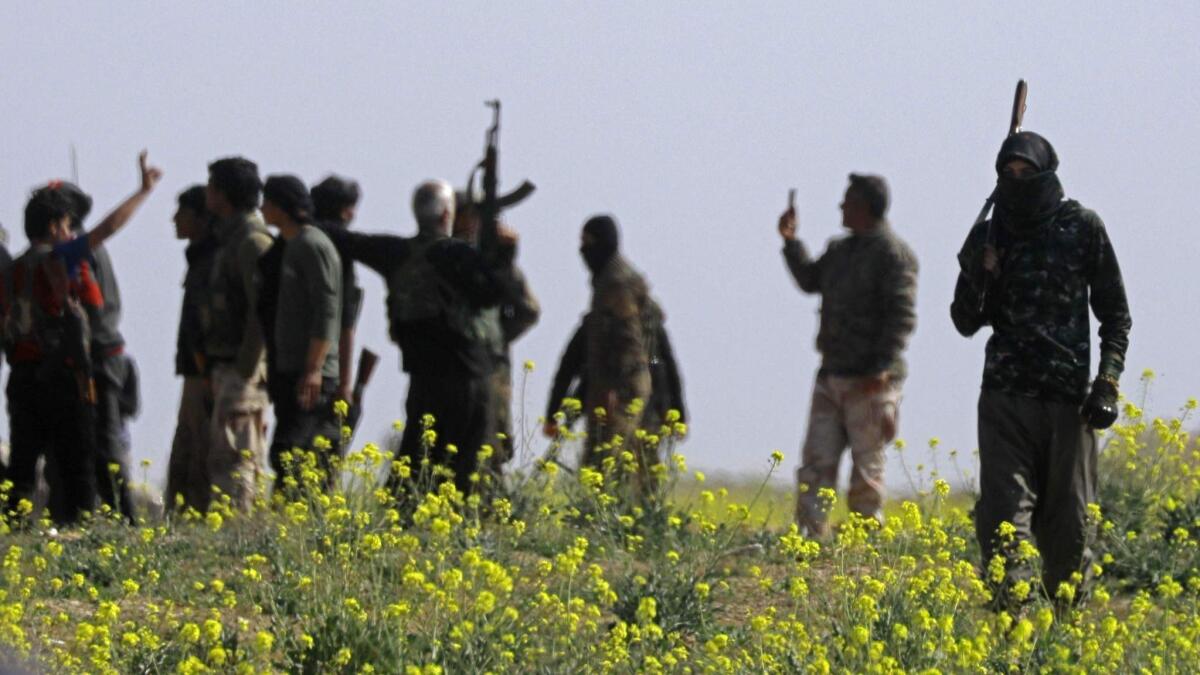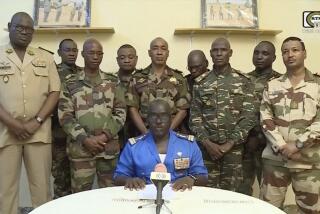Allies ‘unanimously’ say they won’t stay in Syria after U.S. troops withdraw

As the deadline approaches for the withdrawal of U.S. forces fighting the Islamic State in Syria, America’s closest European allies have turned down a Trump administration request to fill the gap with their own troops, according to U.S. and foreign officials.
Allies have “unanimously” told the United States that they “won’t stay if you pull out,” a senior administration official said. France and Britain are the only other countries with troops on the ground in the U.S.-led coalition battling the Islamic State.
Along with the United States, they have provided training, supplies, logistics and intelligence for the Syrian Democratic Forces, the Kurdish-dominated group that has done most of the fighting. U.S., French and British forces also man heavy artillery and conduct the airstrikes that have been decisive against the militants.
French Foreign Minister Jean-Yves Le Drian said last week he was mystified by Trump’s policy. On Tuesday, British Foreign Secretary Jeremy Hunt said there was “no prospect of British forces replacing the Americans” in Syria.
Trump: Where’s my Nobel Prize? »
European refusal to stay unless President Trump reverses at least part of his troop withdrawal order is one of several factors that U.S. military officials, lawmakers and senior administration officials have said should make Trump think again.
Their concerns come as the administration has yet to reach an agreement with Turkey not to attack the SDF, which the nation says is a terrorist group. President Recep Tayyip Erdogan has said the Turkish military, massed at the border, is prepared to move into northeastern Syria once the Americans leave.
One of the principal requests the administration has made of the allies, including Germany, which has no forces in Syria, is to form an “observer” force to patrol a 20-mile-wide “safe zone” on the Syrian side of the border, separating Turkey from the Syrian Kurds.
Officials in Ankara said Turkey’s defense minister, Hulusi Akar, and its military chief of staff would travel to Washington on Thursday to discuss Syria and other regional matters with acting Defense Secretary Patrick Shanahan.
The SDF has appealed to Western nations to keep a force of up to 1,500 in northeast Syria to coordinate air support and back its efforts to hold militants and other adversaries at bay. In anticipation of the departure of about 2,000 U.S. troops, the Kurds are negotiating with Syrian President Bashar Assad and Russia, his primary foreign backer along with Iran.
Russia, meanwhile, has proposed that Assad’s forces simply be allowed to take over the entire area now controlled by the United States and its allies. “No one, including the Kurds and the Turks, thinks the regime coming into the northeast is a good idea,” the senior administration official said.
Trump has long complained that his own top aides and the military were blocking his determination to exit Syria once the Islamic State was defeated. In December, he said the goal had been achieved and that U.S. troops were leaving “now,” after which Defense Secretary Jim Mattis resigned. Trump subsequently agreed that the departure would be “deliberate and orderly.” The military is planning a full withdrawal by the end of April.
But although national security adviser John Bolton, Sen. Lindsey Graham (R-S.C.) and others have told allies that some American troops may remain, those reassurances have not filtered up to the level of a presidential order to the Pentagon.
Senate Republicans break with Trump over plans to pull troops from Syria, Afghanistan »
“I won’t talk to what Sen. Graham or NSA Bolton would like,” a Defense official said. “Gen. Votel has been very clear that we are currently focused on executing a full withdrawal from Syria at the order of the president.” Gen. Joseph Votel is the head of the U.S. Central Command in charge of U.S. forces in the Middle East.
U.S. and foreign officials spoke on the condition of anonymity about the sensitive and ongoing diplomatic discussions and military operations.
In recent weeks, Trump has said that nearly 100% of the wide swath of Iraq and Syria that once formed the Islamic State caliphate has been liberated, although a small patch of militants has stubbornly hung on in the southeast. Trump said Friday that he expected the complete “eradication of the caliphate” to be announced “over the next 24 hours,” but no such announcement has been made.
Military officials have repeatedly flagged what they see as the hazards of a hasty pullout, even after the Islamic State’s territorial presence has been eliminated. Officials expect the group will retain an insurgent capability and the potential to stage a comeback, as it did after the American departure from Iraq in 2011, and they estimate that from 20,000 to 30,000 militants remain in the two countries.
Senior officials, including Gen. Joseph Dunford, the chairman of the Joint Chiefs of Staff, have cautioned that the SDF requires ongoing assistance to stabilize cleared areas.
Last week, Votel said publicly that he did not support Trump’s withdrawal decision.
Graham, who leads a group of lawmakers opposed to the pullout plan, has proposed leaving 200 U.S. troops in northeastern Syria as a way to incentivize European allies.
In a closed-door meeting at last week’s Munich Security Conference, Shanahan faced tough questions from congressional delegates who said he hadn’t articulated a substantive justification for Trump’s exit plans.
“Are you telling our allies that we are going to go to zero by April 30?” Graham asked Shanahan, according to an account Graham gave to Washington Post columnist Josh Rogin. When Shanahan replied that those were the president’s order, Graham said he replied, “That’s the dumbest [expletive] idea I’ve ever heard.” Shanahan, he said, agreed that likely consequences included a return of the Islamic State, a Turkish attack on Kurdish forces and an advantage for Iran.
Lt. Col. Joseph Buccino, a Pentagon spokesman, said the meeting was productive and “ended on a positive note for all parties.”
An official familiar with the Pentagon’s view of the meeting said Shanahan was prepared for tough questions from lawmakers but did not want to appear to be questioning the White House plan. Pentagon officials anticipated that portions of the meeting could be made public.
OPINION: 5 reasons why Trump is right about getting America out of Syria »
Bolton has told allies that even if they withdraw from northern and eastern Syria, U.S. troops would remain at the American garrison at Tanf, on Syria’s southern border with Jordan. Bolton is the administration’s leading hard-liner on Iran and believes, as he recently told reporters, that Tanf “is still very strategically important in connection with our determination that Iran not achieve this arc of control stretching” from Tehran through Iraq, Syria and Lebanon.
But military officials said they had received no such instructions from Trump. The National Security Council declined to comment on the Tanf situation, beyond referring reporters to Bolton’s previous remarks on the subject.
“There is some confusion still in the U.S. government about Tanf,” the senior administration official said, amid rising confusion about what, exactly, Trump’s blueprint entails.
Another U.S. official characterized the situation with Turkey as “gridlock on the U.S. side — a lot of parties not seeing things the same way.”
The two governments appear to have made progress in resolving a subset of their disagreement over the Kurds. They have been conducting joint military patrols in the Syrian town of Manbij, which was retaken from the Islamic State in 2016, and the Americans have agreed to remove 10 SDF fighters from the area in response to Turkish concerns.
But the future of a safe zone is far less clear. For U.S. officials, it has meant reconciling Trump’s withdrawal directive with the reality of the tinderbox that would be left behind. “It’s not safe to leave these enemies there, without any referee or mediating force,” the U.S. official said, referring to the Kurdish fighters and the Turkish military.
On Tuesday, Erdogan called the proposed safe zone, with Turkish forces in charge, “the most practical solution” for the return of millions of Syrian refugees who have settled in Turkey and other countries in the region during an eight-year civil war between Assad and his political opponents. He said it depended on the “material, logistical support of other countries” — a reference to intelligence, surveillance and reconnaissance assistance that Turkey, a member of NATO, has requested from the United States and other countries in the alliance.
Although Erdogan also told Trump that Turkish forces would move farther into Syria to combat Islamic State remnants, U.S. officials said that was unlikely, given their comparatively limited security capabilities.
Karen DeYoung and Missy Ryan write for the Washington Post.
More to Read
Start your day right
Sign up for Essential California for news, features and recommendations from the L.A. Times and beyond in your inbox six days a week.
You may occasionally receive promotional content from the Los Angeles Times.






